Can the Deficit Fall Below $1 Trillion in 2022?
In the calendar year 2021, federal tax revenues surged by an incredible 25% compared to 2020 and were up 22.8% over 2019 (pre-COVID). But the surge in tax revenues was not enough to overcome a record $6.8 trillion in spending, breaking the spending record set in 2020 by 1.6%.
This led to a deficit of -$2.5 trillion, well shy of the record -$3.3 trillion in 2020. But it was still the second-highest deficit on record.
The Fed was “kind” enough to monetize nearly all this spending, but the cost was record increases to the money supply leading to the highest inflation in 40 years.
Note: The Federal Budget Fiscal Year starts in October and runs through September. Because most people think in calendar years, this analysis will analyze the year-end performance of the budget for 2021. This is NOT the true fiscal year. This analysis extends the budget summary released by SchiffGold already.
The current month showed a surge in tax revenues, yet not enough to overcome spending. The deficit in December was -$21B, the lowest since December 2019. The Federal government has now gone more than 2 years without a monthly budget surplus with the last one occurring in September 2019 as shown below.
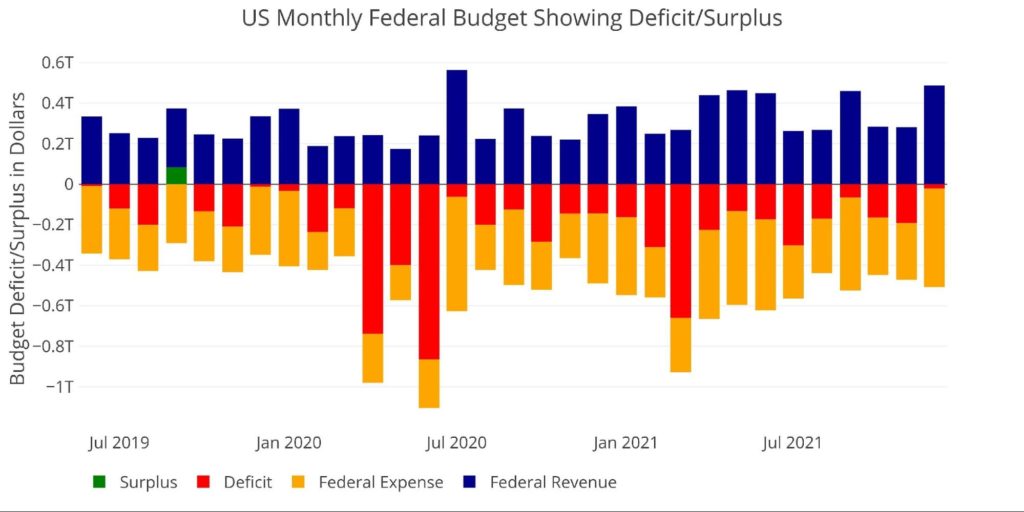
Figure: 1 Monthly Federal Budget
The Sankey diagram below provides a look at spending and revenue. Individual Taxes covered 50% of total spending in December. This compares with only covering 32.5% for the entire year (Figure 3). Health and Human Services (HHS) continue to be the biggest line item in the budget, representing 26.55% of total spending.
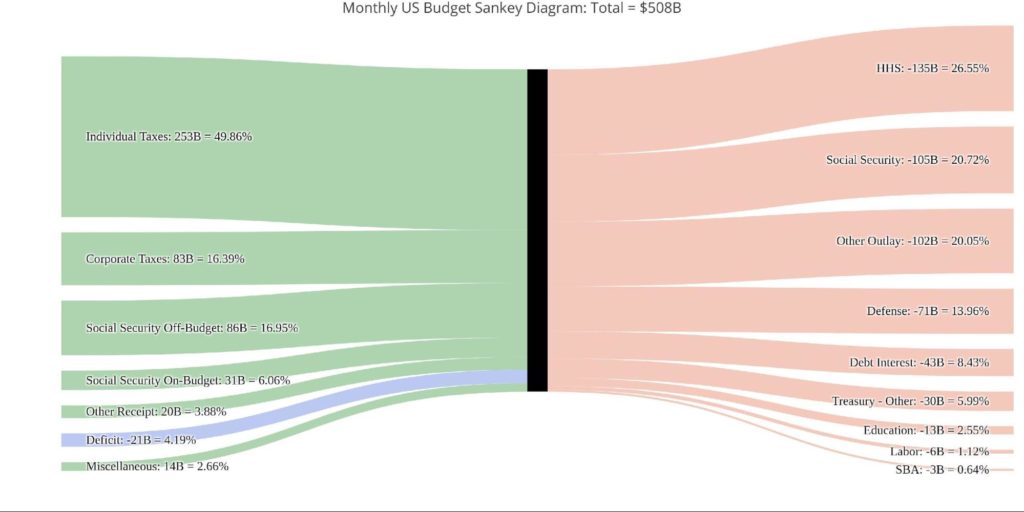
Figure: 2 Monthly Federal Budget Sankey
Comparing the monthly (above) to the yearly (below) shows a few trends to note.
- “Treasury – Other”, which represent stimulus payments, fell from 16.5% for the year down to 6% for December
- SBA (Small Business Association) also shrunk dramatically as PPP loans were phased out (5% to 0.6%)
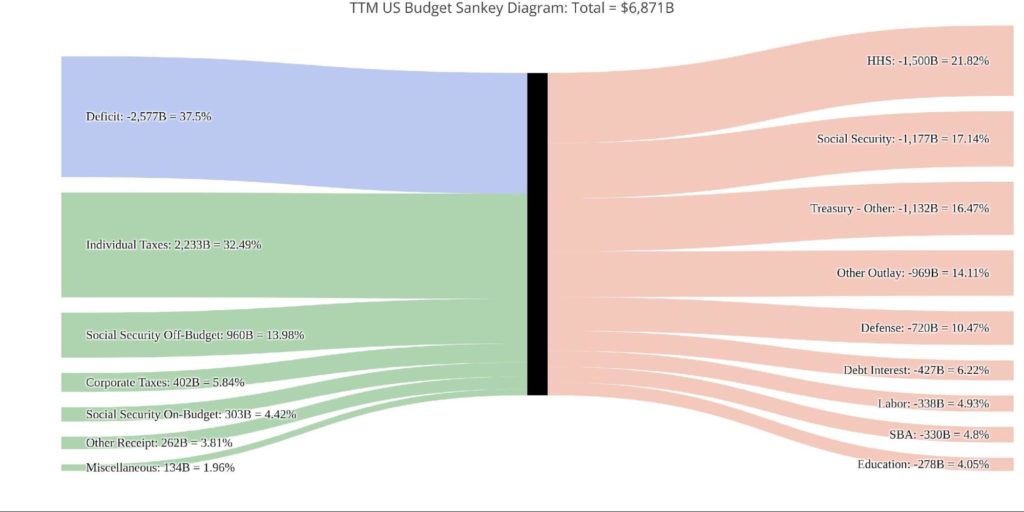
Figure: 3 TTM Federal Budget Sankey
Figure 4 below, expands on the revenue side of Figure 1 above. The light green bars represent Individual Tax Revenues. As shown, there has been a significant increase when compared to the period before Covid.
The Treasury does not offer much detail on the drivers of this increase, but it could be due to Capital Gains and Dividends from the roaring stock market. Some of it could be from the wage inflation showing up as well. A final reason could be the massive government spending that flooded the economy. The Treasury has to hope it’s wage inflation as the other two are both temporary.
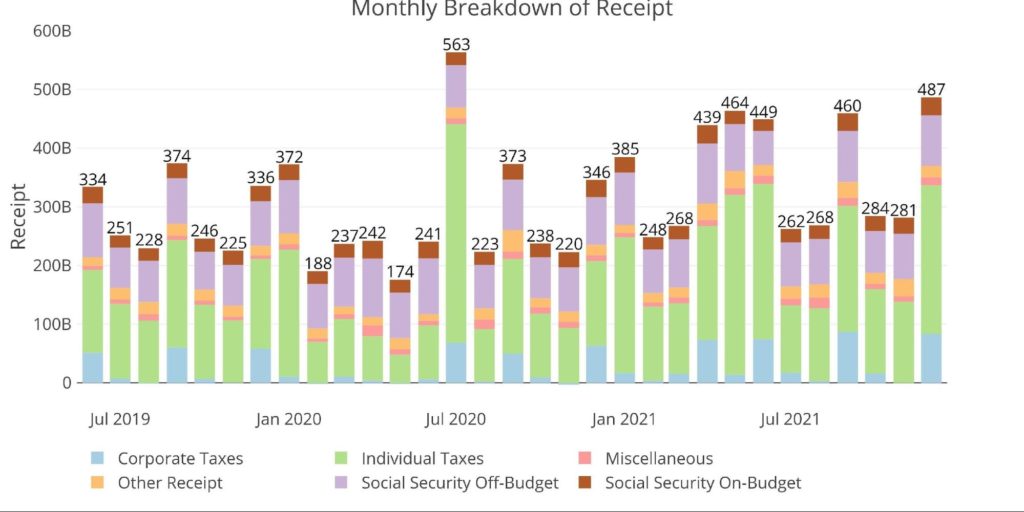
Figure: 4 Monthly Receipts
If the surge in tax revenues continues, it could create a better fiscal picture. As shown below, much of the spending this year came in the first half with stimulus payments. With stimulus having fallen off, if tax revenues stay elevated, it’s possible 2022 could be a “decent” year for the Treasury (decent probably means slightly below $1T… which is really not all that decent).
Of course, this assumes the economy does not go into recession as the Fed attempts to weakly fight inflation using slightly less accommodative policy.
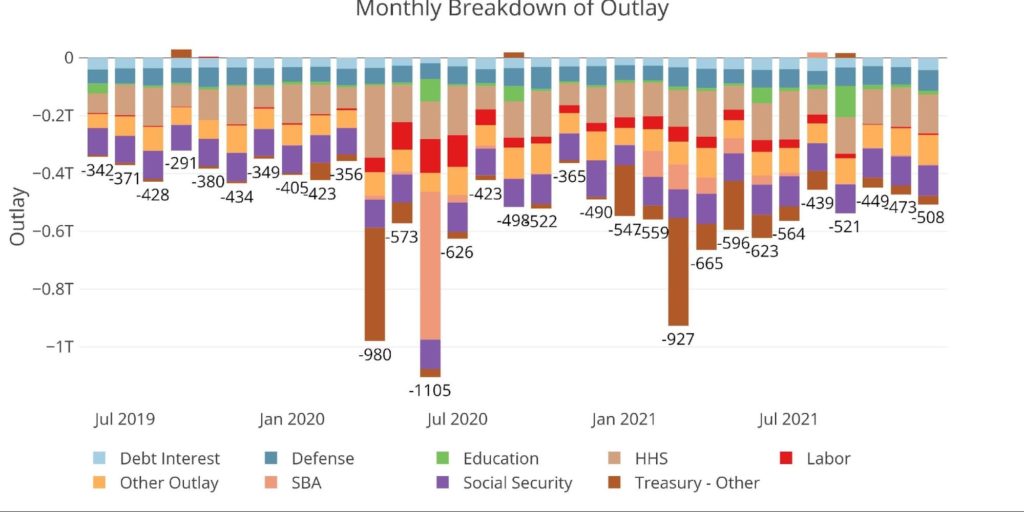
Figure: 5 Monthly Outlays
The table below goes deeper into the numbers of each category. The key takeaways from the charts and table:
Outlays
- Debt Interest is up 14% year over year even though interest rates are unchanged
- Debt Interest is even higher than 2019 when interest rates were between 1-2%
- How will higher interest rates impact the Federal Budget? See this analysis for a deeper dive.
- Spending on Education increased by $70B or 33%
- Labor and SBA spending both fell YoY as PPP and Unemployment spending fell
Receipts
- TTM Individual Taxes ($2.2T) are up nearly 42% YoY ($1.57T) and up 29% from the TTM ending 2019 ($1.7T)
- This is mainly driven by top earners where the top 10% pay 70% of income taxes
- TTM Corporate Taxes ($401B) are up an incredible 86% YoY ($215B) and up 65% from the TTM ending 2019 ($242B)
- Corporate taxes are actually higher than where they were before the 2017 tax cuts
Total
- Total Receipts are up almost $900B in a single year!
- Despite a massive surge in receipts, the deficit is $1.5T larger than it was in the TTM ending Dec 2019
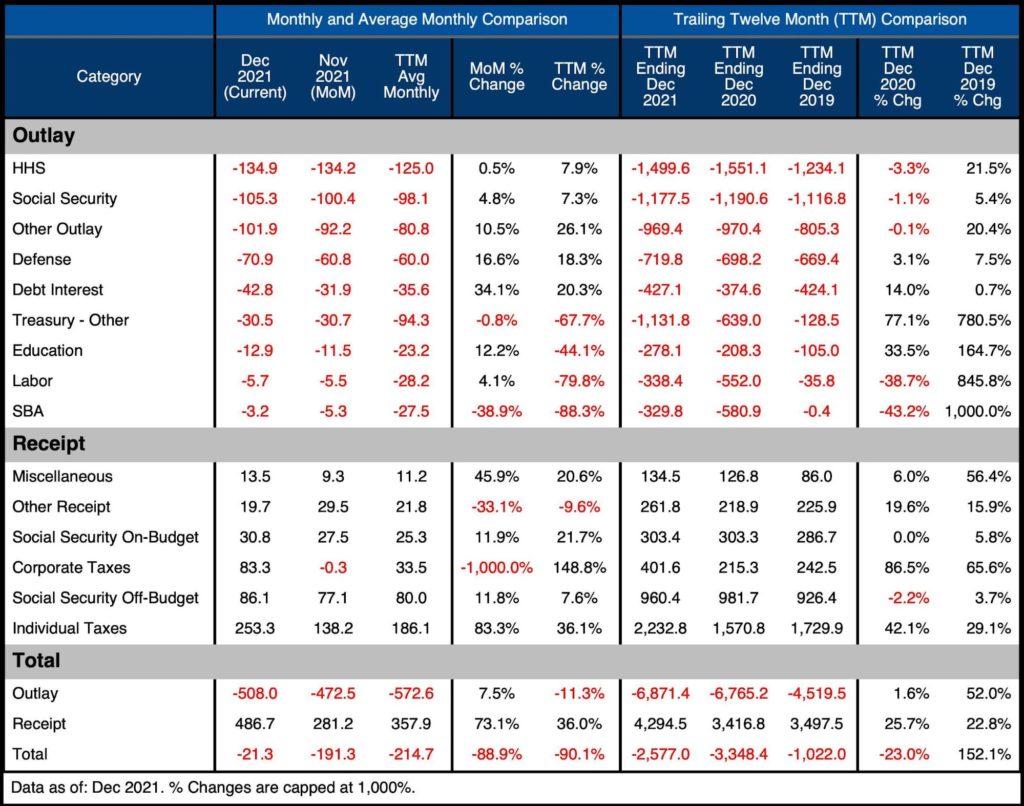
Figure: 6 US Budget Detail
Historical Perspective
Zooming out and looking over the history of the budget back to 1980 shows a complete picture and just how extreme the last two years have been. The chart below shows the data on a TTM basis to smooth out the lines.
As can be seen, Expenses have been flat since June of 2021 but Revenues are still moving upwards.
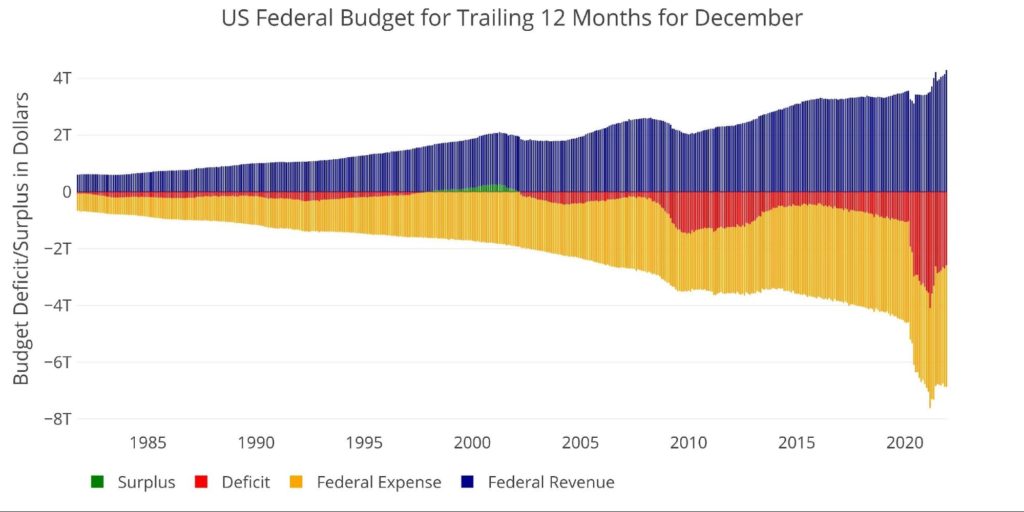
Figure: 7 Trailing 12 Months (TTM)
The next two charts zoom in on the recent periods to show the change when compared to pre-Covid. Once again, the surge in Individual and Corporate Taxes has become very clear.
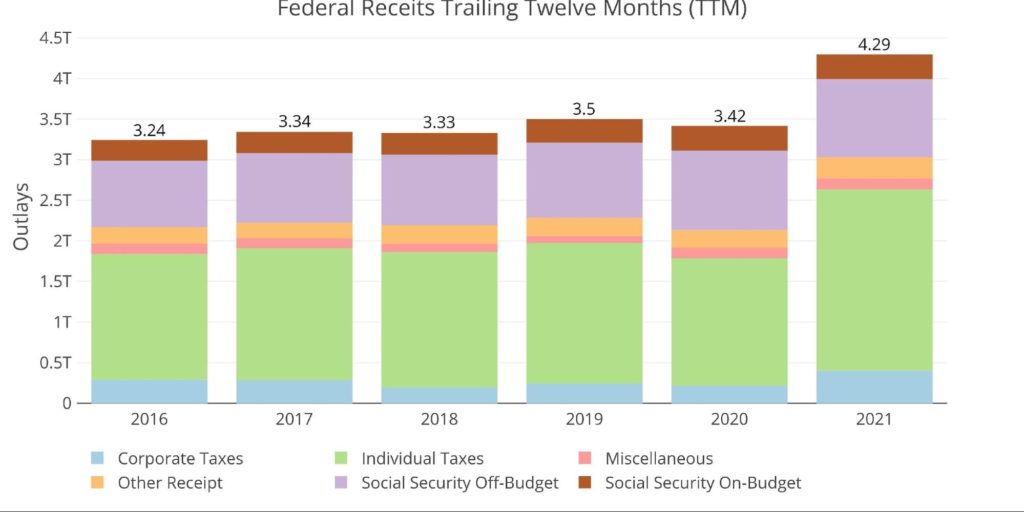
Figure: 8 Annual Federal Receipts
With no more stimulus checks (for now) and the SBA closing the PPP Loan offering, 2022 should fall back down some. It will most likely not reach pre-pandemic levels, but it should get below $6T.
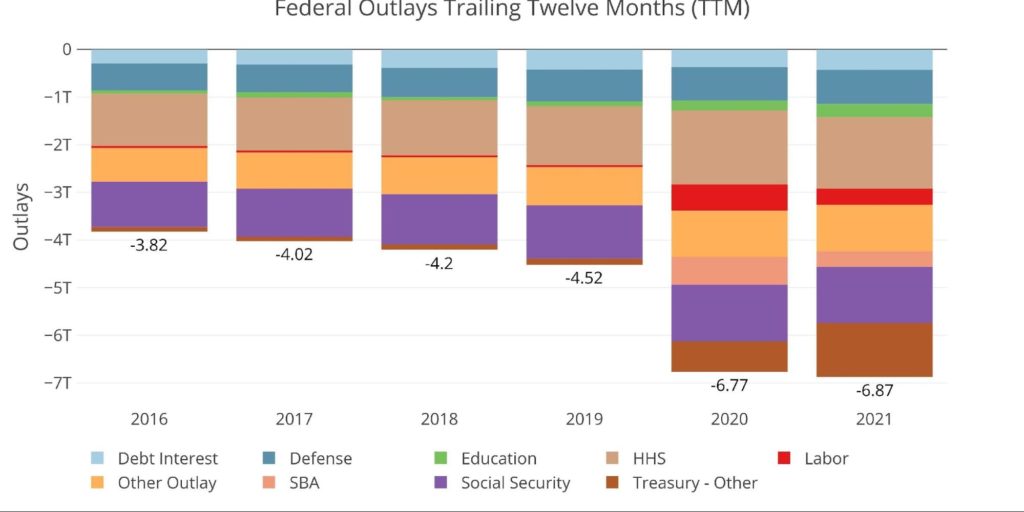
Figure: 9 Annual Federal Expenses
With surging tax revenues and spending set to fall compared to the last two years, the deficit will shrink. Before Covid, the TTM deficit compared to GDP had been trending towards 5% before exploding to 18.6%. It has since come down to 11.1% and will most likely continue falling given the current trends in place.
Note: GDP Axis is set to log scale
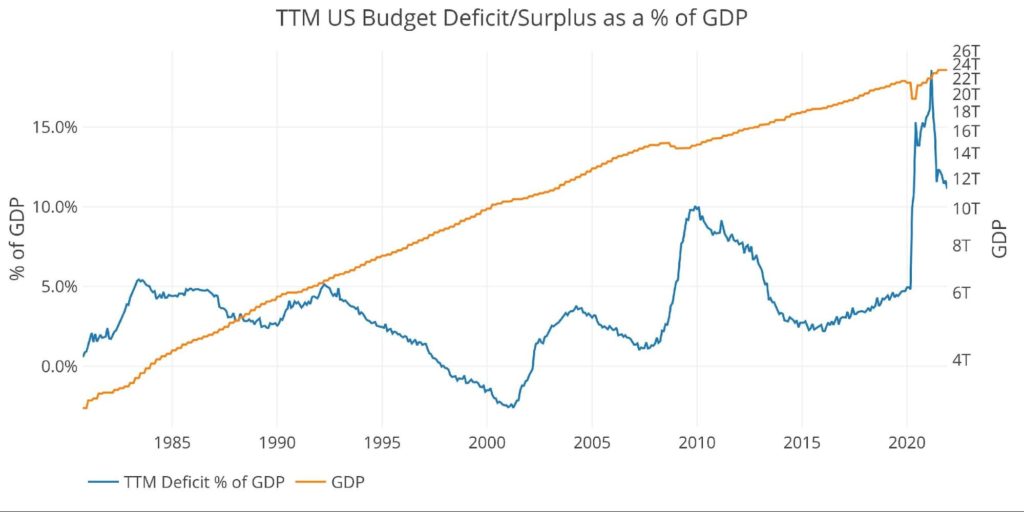
Figure: 10 TTM vs GDP
Finally, to compare the calendar year with previous calendar years, the plot below shows the full-year figures for each year through December. The massive spike in revenues looks even more extreme in this chart, though not as extreme as the massive sending increase in 2020.
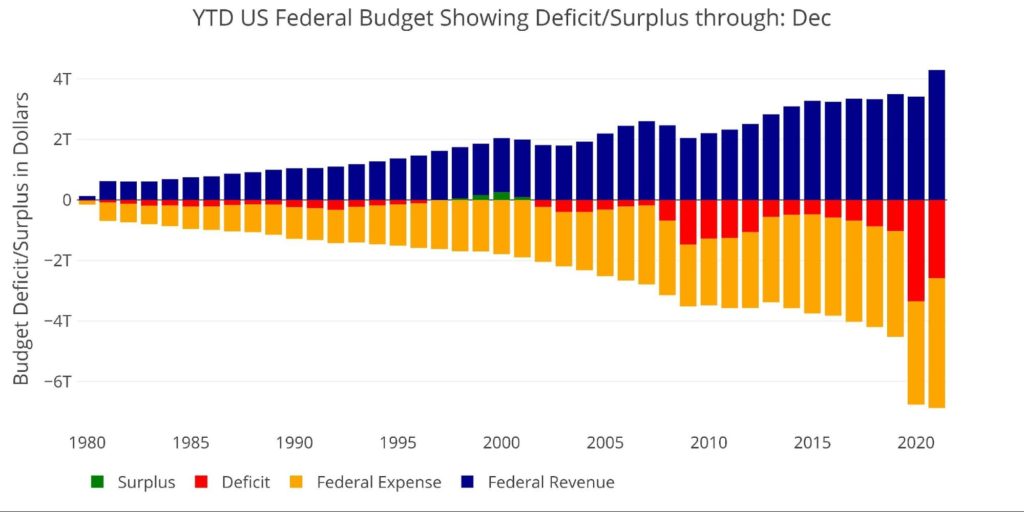
Figure: 11 Year to Date
What it means for Gold and Silver
The Budget Deficit matters for gold and silver because it shows how much the US government needs to borrow to make up for the revenue shortfall. More borrowing usually means higher interest rates. As the debt analysis shows, higher interest rates would prove devastating for the federal budget in the medium to long term and also prove devastating on the rest of the economy (corporate debt, mortgage rates, etc.). The Fed will keep printing to put a ceiling on interest rates… they have to!
The trend does look favorable to see smaller deficits in the years ahead, but it will still be a deficit and it’s not certain to get below $1T much less stay there. Any recession or slowing economy could also crash revenues causing deficits to explode once again. Given the inflation fight the Fed has ahead, it’s likely they will mess something up considering they have no viable options.
Gold and silver will provide insurance against a devalued dollar or an economy and market in turmoil. The current increase in tax revenues could be temporary. If not, politicians will no doubt increase spending with the new “windfall”.
Data Source: Monthly Treasury Statement
Data Updated: Monthly on eighth business day
Last Updated: Period ending Dec 2021
US Debt interactive charts and graphs can always be found on the Exploring Finance dashboard: https://exploringfinance.shinyapps.io/USDebt/





 The Comex report last month showed a lot of strength in gold which directly preceded a massive up move for the price of gold. The data is looking similar in silver this month!
The Comex report last month showed a lot of strength in gold which directly preceded a massive up move for the price of gold. The data is looking similar in silver this month!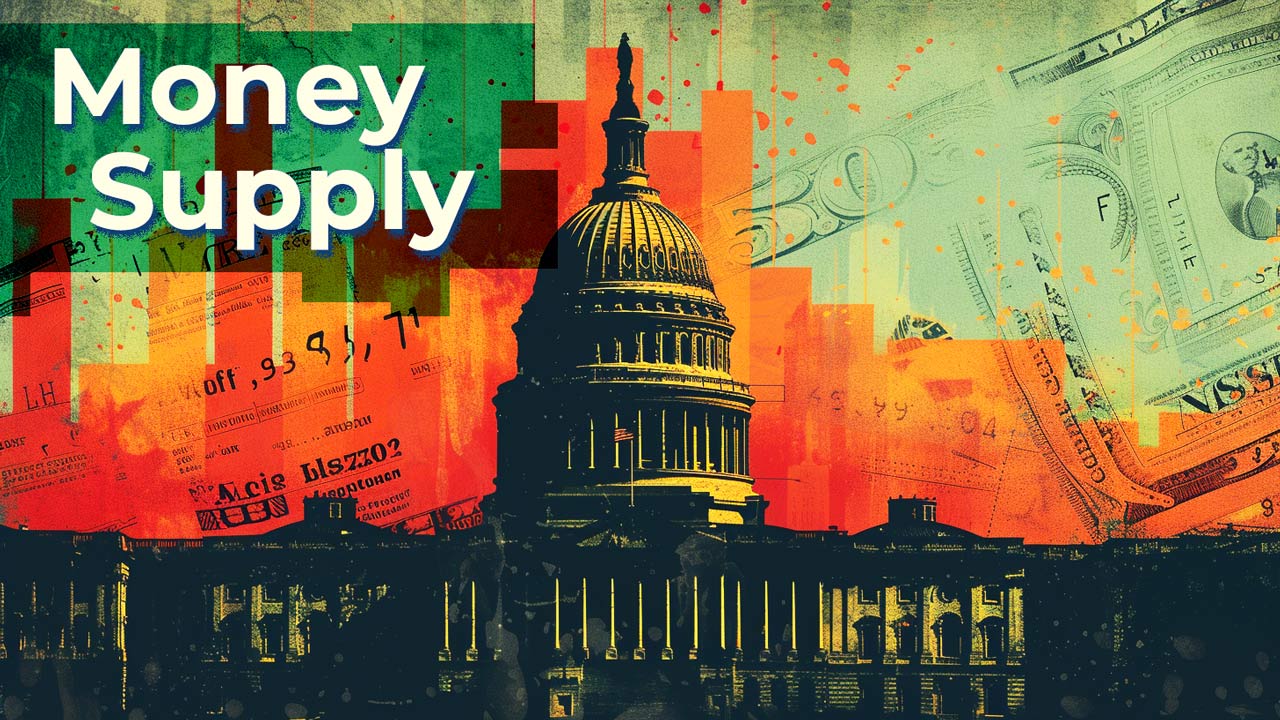 Money Supply is a very important indicator. It helps show how tight or loose current monetary conditions are regardless of what the Fed is doing with interest rates. Even if the Fed is tight, if Money Supply is increasing, it has an inflationary effect.
Money Supply is a very important indicator. It helps show how tight or loose current monetary conditions are regardless of what the Fed is doing with interest rates. Even if the Fed is tight, if Money Supply is increasing, it has an inflationary effect. The analysis below covers the Employment picture released on the first Friday of every month. While most of the attention goes to the headline number, it can be helpful to look at the details, revisions, and other reports to get a better gauge of what is really going on.
The analysis below covers the Employment picture released on the first Friday of every month. While most of the attention goes to the headline number, it can be helpful to look at the details, revisions, and other reports to get a better gauge of what is really going on. In February, the data showed that Yellen was making a big bet that long-term rates would not stay elevated for long. This was demonstrated by the volume of short-term debt issuance. The Treasury was willing to pay higher rates to keep the maturity of the debt shorter.
In February, the data showed that Yellen was making a big bet that long-term rates would not stay elevated for long. This was demonstrated by the volume of short-term debt issuance. The Treasury was willing to pay higher rates to keep the maturity of the debt shorter.